The Depilatory Hair Removal Creams Market is expected to record a valuation of USD 2,951.7 million in 2025 and USD 6,254.3 million in 2035, with an increase of USD 3,302.6 million, which equals a growth of 193% over the decade. The overall expansion represents a CAGR of 7.8% and a near 2X increase in market size.
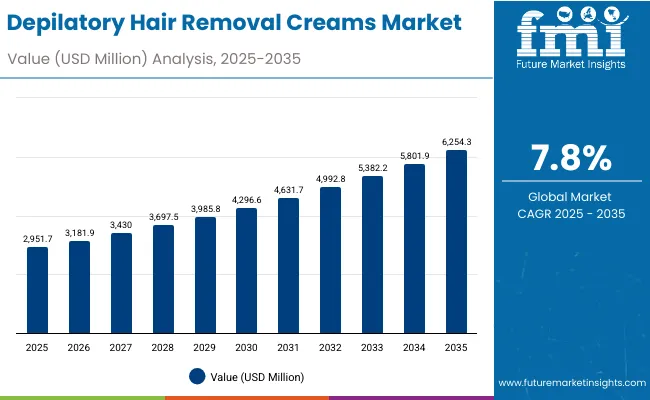
Depilatory Hair Removal Creams Market Key Takeaways
| Metric | Value |
|---|---|
| Depilatory Hair Removal Creams Market Estimated Value in (2025E) | USD 2,951.7 million |
| Depilatory Hair Removal Creams Market Forecast Value in (2035F) | USD 6,254.3 million |
| Forecast CAGR (2025 to 2035) | 7.8% |
During the first five-year period from 2025 to 2030, the market increases from USD 2,951.7 million to USD 4,296.6 million, adding USD 1,344.9 million, which accounts for 41% of the total decade growth. This phase records steady adoption across female grooming, unisex sensitive-skin formulations, and mass-market retail expansion, driven by product accessibility and rising disposable incomes. Cream-based depilatories dominate this period as they cater to over 47% of global sales, supported by their affordability and skin-friendly formulations.
The second half from 2030 to 2035 contributes USD 1,957.7 million, equal to 59% of total growth, as the market jumps from USD 4,296.6 million to USD 6,254.3 million. This acceleration is powered by premiumization trends, wider acceptance among male consumers, and the introduction of enzyme-assisted and post-depilatory soothing complexes. Online platforms and direct-to-consumer (D2C) brands increasingly drive recurring sales, expanding the e-commerce share beyond 55% of total retail value by the end of the decade.
From 2020 to 2024, the Depilatory Hair Removal Creams Market grew steadily, driven by rising consumer awareness of quick, pain-free hair removal solutions and the expanding retail presence of global and regional brands. During this period, the competitive landscape was dominated by multinational personal care manufacturers holding nearly 70% of global sales, with leaders such as Veet (Reckitt Benckiser) and Nair (Church & Dwight) focusing on product safety, dermatological validation, and fragrance-free variants. Competitive differentiation relied on skin compatibility, brand reputation, and price accessibility, while organic and sensitive-skin lines began gaining traction through online retail channels. Professional and salon-based depilatory products contributed less than 10% of total market value.
Demand for depilatory hair removal creams will expand to USD 2,951.7 million in 2025, and the revenue mix will continue to shift toward enzyme-assisted and post-depilatory soothing formulations, which already account for more than 52% of ingredient-based value share. Traditional leaders face rising competition from D2C and natural beauty brands offering vegan, paraben-free, and cruelty-free solutions. Major FMCG players are pivoting toward gender-neutral and sustainability-driven formulations, integrating recyclable packaging and plant-based actives to retain relevance. Emerging entrants specializing in sensitive-skin and quick-rinse formulations are gaining share, signaling that the next phase of competition will favor ingredient transparency, product safety, and digital-first consumer engagement strategies.
The depilatory hair removal creams market is growing as consumers increasingly prefer convenient, pain-free alternatives to salon waxing or laser treatments. Urban lifestyles, time constraints, and affordability are driving the popularity of at-home solutions, particularly among women and young adults. Continuous innovations such as quick-rinse formulas, sensitive-skin variants, and pleasant fragrances are enhancing user experience, resulting in higher adoption rates across emerging economies and boosting overall category expansion.
Market growth is further supported by the surge in gender-neutral and dermatologically tested depilatory creams catering to broader demographics. Brands are investing in enzyme-assisted and soothing ingredient blends that minimize irritation and suit sensitive skin, expanding their appeal to men and unisex consumers. This shift, combined with strong e-commerce availability and social media-driven grooming trends, has diversified the customer base and increased purchase frequency, solidifying long-term market momentum worldwide.
The Depilatory Hair Removal Creams Market is segmented by product type, key ingredients, application area, distribution channel, end user, and region. By product type, it includes creams, lotions, foams/aerosols, and roll-on gels, with creams dominating global sales due to ease of use and skin compatibility. Key ingredient segmentation covers calcium/alkali thioglycolate systems, enzyme-assisted blends, and soothing post-depilatory complexes, reflecting growing demand for gentle and natural formulations. Application areas include legs and arms, underarms, bikini/intimate zones, and face, capturing varied consumer grooming needs.
Distribution channels span supermarkets and hypermarkets, pharmacies and drugstores, e-commerce, and salons or professional supply outlets, with online retail showing the fastest growth. By end user, the market covers women, men, and unisex sensitive-skin users, reflecting inclusivity trends. Geographically, the market is analyzed across North America, Europe, East Asia, South Asia & Pacific, Latin America, and the Middle East & Africa, highlighting diverse consumer behavior and product adoption patterns worldwide.
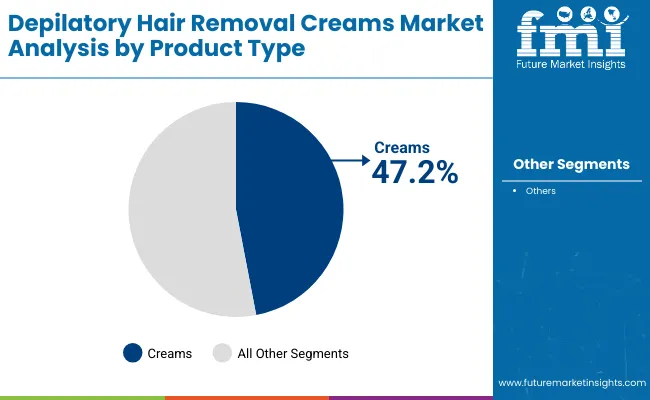
| Product Type | Value Share% 2025 |
|---|---|
| Creams | 47.2% |
| Others | 52.8% |
The creams segment is projected to contribute 47.2% of the Depilatory Hair Removal Creams Market revenue in 2025, maintaining its position as the leading product type category. This dominance is driven by the growing preference for quick, pain-free, and affordable hair removal options that can be easily applied at home. Creams are favored for their skin-friendly formulations enriched with moisturizing and soothing agents, catering to both women and unisex sensitive-skin users.
The segment’s expansion is further supported by innovation in enzyme-based and dermatologically tested formulations that reduce irritation while improving fragrance and texture. As consumer demand shifts toward convenience and natural ingredients, the creams segment is expected to remain the cornerstone of depilatory product sales globally.
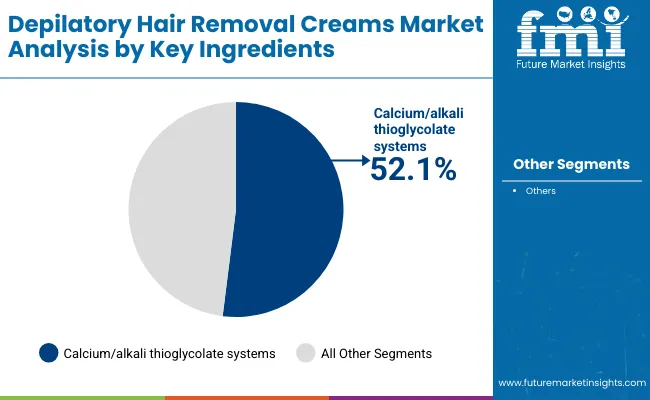
| Key Ingredients | Value Share% 2025 |
|---|---|
| Calcium/alkali thioglycolate systems | 52.1% |
| Others | 47.9% |
The calcium/alkali thioglycolate systems segment is forecasted to hold 52.1% of the Depilatory Hair Removal Creams Market share in 2025, driven by its strong performance in delivering effective and rapid hair removal results. These formulations chemically dissolve hair close to the root while maintaining a smoother skin finish, making them ideal for legs, arms, and underarm applications. Their efficiency, affordability, and compatibility with mass-market depilatory creams have ensured their continued dominance.
The segment’s growth is further supported by reformulations that balance pH levels and incorporate soothing agents to minimize irritation and improve fragrance stability. As brands prioritize safety, dermatological approval, and faster results, calcium/alkali thioglycolate systems are expected to remain the preferred base ingredient in global depilatory cream production.
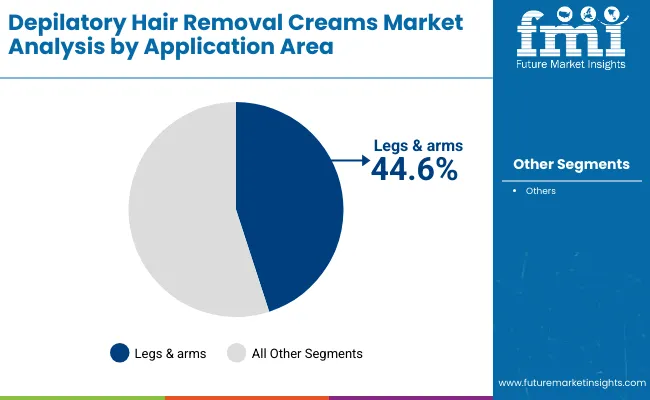
| Application Area | Value Share% 2025 |
|---|---|
| Legs & arms | 44.6% |
| Others | 55.4% |
The legs and arms segment is projected to account for 44.6% of the Depilatory Hair Removal Creams Market revenue in 2025, establishing it as the most prominent application area. This dominance stems from the high frequency of hair removal routines for these body parts, where consumers prioritize quick, painless, and evenly spread application results. Depilatory creams designed for legs and arms emphasize moisturizing and soothing properties, allowing smoother skin texture post-use without irritation.
The segment’s expansion is further supported by product innovations such as quick-rinse formulas, hydrating complexes, and fragrance-enhanced variants that appeal to women and unisex consumers alike. As grooming routines become more integrated into everyday self-care, legs and arms are expected to remain the largest and most consistent area of application in the depilatory market.
Rising Demand for Convenient and Pain-Free Hair Removal Solutions
The depilatory hair removal creams market is witnessing strong growth due to rising consumer preference for quick, pain-free alternatives to waxing and shaving. Busy lifestyles and the growing influence of beauty standards across both men and women have accelerated the adoption of creams that deliver smooth skin with minimal effort. Continuous product innovations, such as fast-acting and dermatologically tested formulas, are enhancing consumer satisfaction. This shift toward convenience-driven grooming routines is strengthening brand loyalty and expanding market penetration across both developed and emerging economies.
Expansion of E-commerce and Direct-to-Consumer Channels
The rapid growth of e-commerce platforms and brand-owned digital stores has transformed the distribution landscape for depilatory creams. Consumers now have easier access to a wide variety of products, including sensitive-skin and organic variants, supported by personalized marketing and subscription-based delivery models. Online reviews and influencer-led campaigns are shaping purchase behavior, particularly among Gen Z and millennial consumers. This online visibility not only drives repeat sales but also allows brands to gather valuable data on consumer preferences, enabling targeted innovation and expanding their market reach globally.
Skin Sensitivity and Chemical Concerns
Despite growing demand, market expansion is restrained by concerns related to skin irritation, allergic reactions, and potential side effects from chemical ingredients such as thioglycolates. Consumers with sensitive skin often hesitate to use depilatory creams due to fears of burns or dryness. This has prompted stricter regulatory oversight and increased demand for natural alternatives. Brands are under pressure to improve ingredient transparency and dermatological safety while maintaining product efficacy. The need to balance performance and mildness continues to pose a challenge for large-scale consumer acceptance, especially in emerging markets.
Growth in Male Grooming and Unisex Product Lines
A major opportunity lies in the expanding male grooming segment and the rise of unisex depilatory formulations. Changing perceptions of personal care, coupled with social media influence, are encouraging men to adopt easy hair removal routines. Brands introducing gender-neutral packaging and formulations suitable for coarse hair are tapping into an underserved demographic. This trend is further supported by the increasing popularity of at-home grooming kits and sensitive-skin variants designed for universal use. The growing inclusivity and diversification of grooming preferences present a significant growth avenue for global depilatory cream manufacturers.
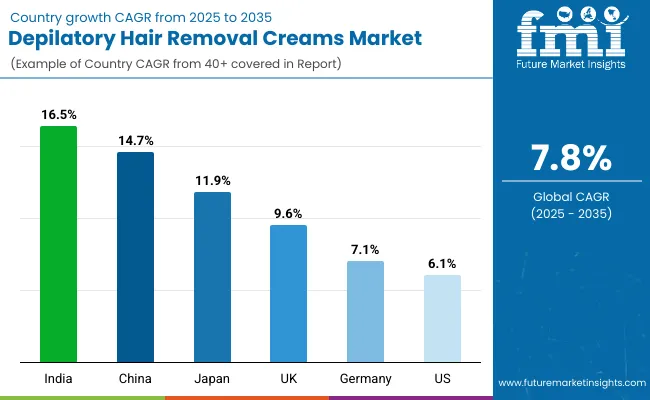
| Countries | Estimated CAGR (2025 to 2035) |
|---|---|
| China | 14.7% |
| USA | 6.1% |
| India | 16.5% |
| UK | 9.6% |
| Germany | 7.1% |
| Japan | 11.9% |
The global Depilatory Hair Removal Creams Market displays significant regional variations, primarily influenced by grooming awareness, disposable income, and gender-neutral beauty adoption. Asia-Pacific emerges as the fastest-growing region, led by India (16.5%) and China (14.7%), where urbanization, affordability, and rising middle-class spending are fueling adoption of mass-market depilatory products. E-commerce penetration and influencer-driven beauty trends have accelerated growth, especially among younger consumers seeking convenient, pain-free solutions.
In China, innovation in enzyme-assisted formulations and local brand diversification are boosting demand for natural and sensitive-skin depilatory creams. India’s high CAGR reflects expanding beauty and personal care consumption beyond metropolitan areas, supported by aggressive retail distribution and affordable pricing strategies. Japan also posts robust growth at 11.9%, driven by premium formulations emphasizing skin sensitivity and aesthetic quality.
Europe maintains a strong growth trajectory, led by the UK (9.6%) and Germany (7.1%), where sustainability, dermatological testing, and clean-label product trends dominate consumer choices. European consumers exhibit higher brand loyalty and preference for vegan, paraben-free creams.
North America, represented by the USA (6.1%), shows stable yet mature growth, reflecting widespread product availability and premiumization trends. Demand is driven by self-care culture and inclusivity in marketing that normalizes male grooming. Overall, while mature regions emphasize product differentiation and sustainability, emerging markets such as India and China drive global momentum through affordability, accessibility, and rising personal grooming awareness.
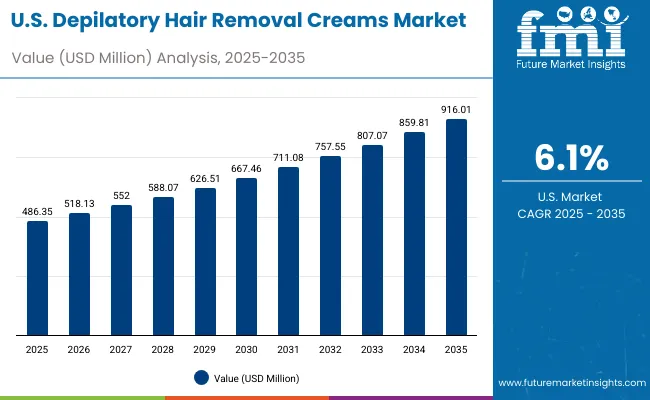
| Year | USA Depilatory Hair Removal Creams Market (USD Million) |
|---|---|
| 2025 | 486.35 |
| 2026 | 518.13 |
| 2027 | 552.00 |
| 2028 | 588.07 |
| 2029 | 626.51 |
| 2030 | 667.46 |
| 2031 | 711.08 |
| 2032 | 757.55 |
| 2033 | 807.07 |
| 2034 | 859.81 |
| 2035 | 916.01 |
The Depilatory Hair Removal Creams Market in the United States is projected to grow at a CAGR of 6.1% from 2025 to 2035, driven by strong consumer adoption of quick, non-invasive, and affordable hair removal solutions. Growth is supported by expanding product availability across retail pharmacies, supermarkets, and e-commerce platforms. Premium depilatory formulations enriched with aloe vera, shea butter, and vitamin E are appealing to consumers seeking moisturizing and skin-safe alternatives to waxing and shaving. Male grooming products are also witnessing higher uptake through gender-neutral marketing and sensitive-skin variants.
Increased online purchasing behavior and social media influence are fostering strong brand visibility for leading players such as Veet, Nair, and Sally Hansen. Subscription-based sales and targeted influencer campaigns are further supporting retention rates among millennial and Gen Z consumers. Product innovation focused on dermatologically approved, fragrance-free, and cruelty-free formulations continues to define competitive differentiation in the USA market.
The Depilatory Hair Removal Creams Market in the United Kingdom is expected to grow at a CAGR of 9.6% from 2025 to 2035, supported by the country’s evolving beauty and personal care landscape. British consumers increasingly prioritize convenience, inclusivity, and sustainability in grooming routines, driving the shift from salon-based waxing to at-home depilatory creams. Demand is rising for vegan, cruelty-free, and dermatologically tested formulations, reflecting strong alignment with ethical beauty trends. Premium brands are expanding their presence through pharmacies and online retail, while local niche players emphasize botanical and fragrance-free products to appeal to sensitive-skin users.
The UK market’s growth is further strengthened by the proliferation of subscription-based D2C brands, influencer-led marketing, and retailer partnerships with established beauty chains. Men’s grooming and gender-neutral depilatory creams are emerging as fast-expanding categories, encouraged by inclusive advertising and broader cultural acceptance of self-care. Continuous product innovation focused on quick-rinse, low-odor, and skin-conditioning variants is shaping consumer loyalty and repurchase behavior.
India is witnessing rapid growth in the Depilatory Hair Removal Creams Market, which is forecast to expand at a CAGR of 16.5% through 2035. This strong expansion is driven by rising beauty consciousness, expanding retail penetration, and increasing affordability of personal grooming products across both metropolitan and tier-2 cities. Local and international brands are actively launching herbal, paraben-free, and dermatologically tested depilatory creams suited to Indian skin tones and climatic conditions. Growing participation of women in the workforce and the popularity of quick, at-home beauty routines have further accelerated adoption.
The surge in e-commerce platforms such as Nykaa, Amazon, and Flipkart, along with social media-led brand promotions, is strengthening product visibility and accessibility across diverse consumer groups. Additionally, smaller domestic players are entering the market with ayurvedic and plant-based formulations, appealing to health-conscious buyers seeking natural alternatives.
The Depilatory Hair Removal Creams Market in China is expected to grow at a CAGR of 14.7%, the highest among leading economies during 2025-2035. This robust momentum is driven by the growing beauty and personal care culture, increasing urbanization, and strong demand for affordable, fast-acting depilatory solutions among young consumers. The shift toward self-grooming and hygiene maintenance has been amplified by rising disposable incomes and the popularity of at-home beauty products. Domestic brands are expanding rapidly, offering enzyme-assisted and herbal depilatory creams that cater to the preferences of Chinese consumers seeking gentle, non-irritating formulations.
E-commerce giants such as Tmall, JD.com, and Douyin are fueling digital growth through product customization, influencer-led marketing, and promotional bundling with skincare essentials. Meanwhile, premium and international brands are localizing formulations to align with skin sensitivity and fragrance preferences. The affordability and accessibility of products, coupled with increased grooming awareness among both genders, are expected to keep China at the forefront of global market expansion.
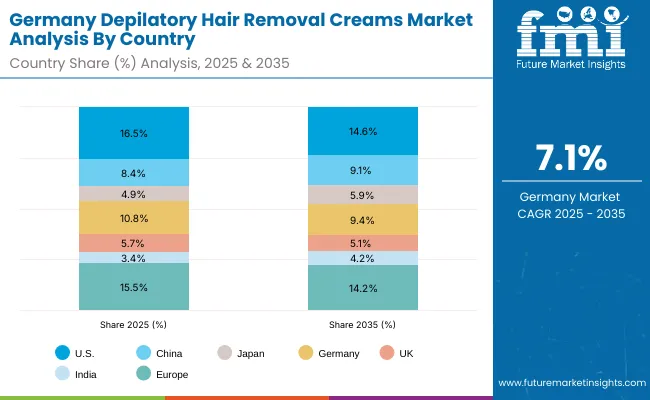
| Countries | 2025 Share (%) |
|---|---|
| USA | 16.5% |
| China | 8.4% |
| Japan | 4.9% |
| Germany | 10.8% |
| UK | 5.7% |
| India | 3.4% |
| Countries | 2035 Share (%) |
|---|---|
| USA | 14.6% |
| China | 9.1% |
| Japan | 5.9% |
| Germany | 9.4% |
| UK | 5.1% |
| India | 4.2% |
The Depilatory Hair Removal Creams Market in Germany is projected to grow at a CAGR of 7.1%, supported by high consumer awareness, premium beauty standards, and strong demand for dermatologically tested and eco-certified skincare products. German consumers exhibit a high preference for vegan, fragrance-free, and sensitive-skin depilatory creams, reflecting the country’s broader sustainability and clean-beauty movement. Established European brands such as Veet and Nair continue to dominate, but local niche players are gaining momentum with plant-based, cruelty-free alternatives emphasizing ingredient transparency.
The market’s expansion is also being driven by the growing male grooming segment, especially among younger demographics, supported by marketing that normalizes body hair removal for all genders. Pharmacies and drugstores remain key retail channels, while online platforms such as Douglas and Amazon Germany are expanding access to specialized products for different skin types. The rising influence of dermatologist recommendations, combined with sustainable packaging innovation and natural formulations, positions Germany as one of Europe’s most mature and eco-conscious markets.
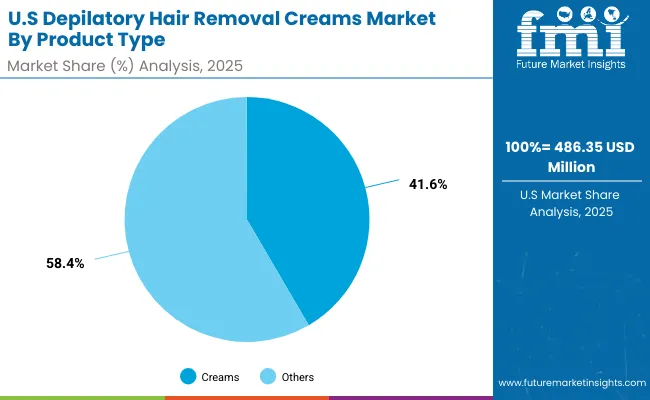
| USA By Product Type | Value Share% 2025 |
|---|---|
| Creams | 41.6% |
| Others | 58.4% |
The Depilatory Hair Removal Creams Market in the United States is projected to reach USD 486.35 million in 2025, led by sustained consumer demand for convenient, quick, and non-irritating hair removal solutions. Creams, holding a 41.6% share, remain the most preferred product type due to their accessibility and ability to provide smooth results without professional assistance. This segment continues to expand as consumers shift away from shaving and waxing toward pain-free alternatives suited for daily grooming routines.
The growth trajectory is supported by innovation in moisturizing and fragrance-free depilatory formulations, appealing to women and men with sensitive skin. Rising awareness of personal hygiene, particularly among working professionals, and the growing popularity of self-care products are propelling the USA market forward. E-commerce channels such as Amazon, Walmart, and Target have amplified visibility for both mass and premium brands, while D2C entrants are attracting younger audiences through subscription models and influencer-led campaigns.
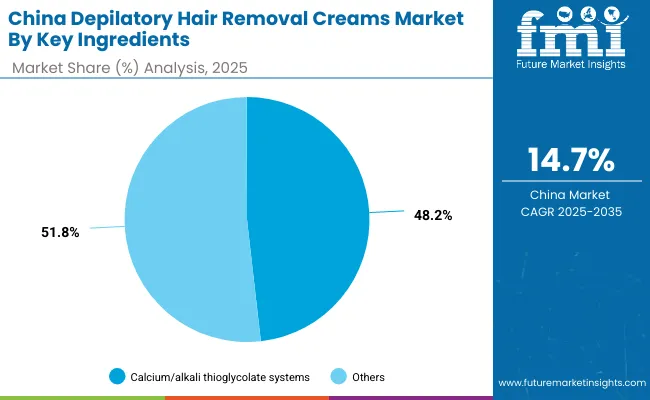
| China By Key Ingredients | Value Share% 2025 |
|---|---|
| Calcium/alkali thioglycolate systems | 48.2% |
| Others | 51.8% |
The Depilatory Hair Removal Creams Market in China presents one of the strongest growth opportunities globally, fueled by rising consumer awareness of personal grooming, hygiene, and skincare sophistication. The market is driven by a younger demographic embracing quick, at-home beauty solutions supported by digital retail ecosystems and influencer marketing. The preference for enzyme-assisted and mild thioglycolate-based formulations reflects a major shift toward skin-friendly and non-irritating depilatory options. With a 48.2% share, calcium/alkali thioglycolate systems remain foundational, though brands are investing in blends with botanical extracts and soothing actives to meet local consumer expectations for safety and fragrance.
China’s opportunity lies in the intersection of e-commerce dominance and localized innovation. Domestic brands are leveraging platforms like Tmall, Douyin, and JD.com to reach mass audiences with customized depilatory solutions, while international brands are tailoring ingredients for Asian skin sensitivity. The growth of men’s grooming, along with increased acceptance of hair removal as part of everyday hygiene, further expands the addressable market. The government’s focus on supporting local beauty startups through digital entrepreneurship and manufacturing incentives also enhances scalability.
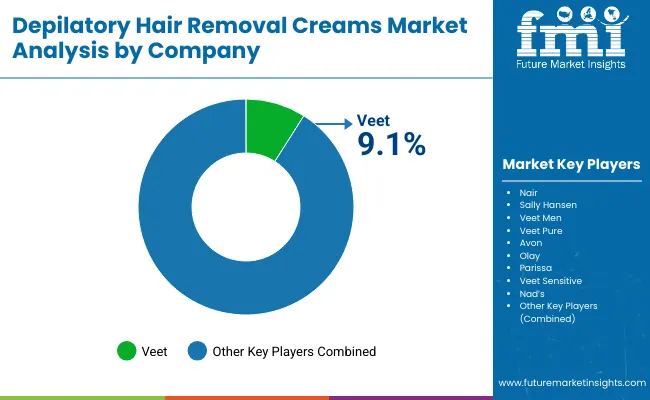
The Depilatory Hair Removal Creams Market is moderately fragmented, featuring a blend of global beauty leaders, regional manufacturers, and niche brands focusing on natural and dermatological formulations. Veet, owned by Reckitt Benckiser, leads the market with a 9.1% global value share, supported by a diverse product portfolio covering sensitive-skin, men’s, and natural variants. The brand’s consistent investment in marketing, dermatological testing, and distribution across both offline and e-commerce channels reinforces its leadership position.
Mid-sized and emerging brands such as Nair (Church & Dwight), Sally Hansen, and Olay are intensifying competition by expanding gender-inclusive and quick-rinse formulations. These companies emphasize consumer trust through skin-safe ingredients, attractive packaging, and affordability, targeting mass-market consumers seeking convenient hair removal solutions. Niche players including Parissa and Nad’s focus on organic, hypoallergenic, and cruelty-free alternatives, appealing to eco-conscious buyers and consumers with sensitive skin concerns.
Competitive differentiation in this market is shifting from product strength alone to formulation innovation, ingredient transparency, and sustainability. Brands are increasingly integrating plant-based actives, recyclable packaging, and digital marketing ecosystems to capture young, urban consumers. Collaborations with dermatologists and beauty influencers are becoming central to credibility and consumer loyalty, ensuring continuous engagement in a market driven by hygiene, convenience, and personalization trends.
Key Developments in Depilatory Hair Removal Creams Market
| Item | Value |
|---|---|
| Quantitative Units | USD 2,951.7 Million |
| Product Type | Creams, Lotions, Foams/Aerosols, Roll-on Gels |
| Key Ingredients | Calcium/Alkali Thioglycolate Systems, Enzyme-Assisted Blends, Soothing Post-Depilatory Complexes |
| Application Area | Legs & Arms, Underarms, Bikini/Intimate, Face |
| Channel | Supermarkets & Hypermarkets, Pharmacies & Drugstores, E-commerce, Salons & Professional Supply |
| End User | Women, Men, Unisex Sensitive-Skin Users |
| Regions Covered | North America, Europe, Asia-Pacific, Latin America, Middle East & Africa |
| Country Covered | United States, Canada, Germany, France, United Kingdom, China, Japan, India, Brazil, South Africa |
| Key Companies Profiled | Veet, Nair, Sally Hansen, Veet Men, Veet Pure, Avon, Olay, Parissa, Veet Sensitive, Nad’s |
| Additional Attributes | Dollar sales by product type and distribution channel, evolving consumer adoption trends in at-home grooming and personal hygiene, and rising demand for sensitive-skin and enzyme-based depilatory formulations are shaping market dynamics. Growth is also driven by expanding e-commerce penetration, increased sales of portable and travel-friendly depilatory creams, and sector-specific expansion across beauty retail, pharmacies, and online direct-to-consumer (D2C) platforms. Revenue segmentation highlights strong contributions from cream-based and unisex-sensitive formulations, while innovations focus on herbal ingredients, fragrance-neutral blends, and recyclable packaging. |
The global Depilatory Hair Removal Creams Market is estimated to be valued at USD 2,951.7 million in 2025.
The market size for the Depilatory Hair Removal Creams Market is projected to reach USD 6,254.3 million by 2035.
The Depilatory Hair Removal Creams Market is expected to grow at a 7.8% CAGR between 2025 and 2035.
The key product types in the Depilatory Hair Removal Creams Market are creams, lotions, foams/aerosols, and roll-on gels. Among these, creams hold the dominant share owing to their easy application, quick results, and compatibility with a wide range of skin types, including sensitive skin.
In terms of product type, the creams segment is projected to command a 47.2% share in the Depilatory Hair Removal Creams Market in 2025, driven by rising demand for pain-free, affordable, and dermatologically tested hair removal solutions.






Our Research Products

The "Full Research Suite" delivers actionable market intel, deep dives on markets or technologies, so clients act faster, cut risk, and unlock growth.

The Leaderboard benchmarks and ranks top vendors, classifying them as Established Leaders, Leading Challengers, or Disruptors & Challengers.

Locates where complements amplify value and substitutes erode it, forecasting net impact by horizon

We deliver granular, decision-grade intel: market sizing, 5-year forecasts, pricing, adoption, usage, revenue, and operational KPIs—plus competitor tracking, regulation, and value chains—across 60 countries broadly.

Spot the shifts before they hit your P&L. We track inflection points, adoption curves, pricing moves, and ecosystem plays to show where demand is heading, why it is changing, and what to do next across high-growth markets and disruptive tech

Real-time reads of user behavior. We track shifting priorities, perceptions of today’s and next-gen services, and provider experience, then pace how fast tech moves from trial to adoption, blending buyer, consumer, and channel inputs with social signals (#WhySwitch, #UX).

Partner with our analyst team to build a custom report designed around your business priorities. From analysing market trends to assessing competitors or crafting bespoke datasets, we tailor insights to your needs.
Supplier Intelligence
Discovery & Profiling
Capacity & Footprint
Performance & Risk
Compliance & Governance
Commercial Readiness
Who Supplies Whom
Scorecards & Shortlists
Playbooks & Docs
Category Intelligence
Definition & Scope
Demand & Use Cases
Cost Drivers
Market Structure
Supply Chain Map
Trade & Policy
Operating Norms
Deliverables
Buyer Intelligence
Account Basics
Spend & Scope
Procurement Model
Vendor Requirements
Terms & Policies
Entry Strategy
Pain Points & Triggers
Outputs
Pricing Analysis
Benchmarks
Trends
Should-Cost
Indexation
Landed Cost
Commercial Terms
Deliverables
Brand Analysis
Positioning & Value Prop
Share & Presence
Customer Evidence
Go-to-Market
Digital & Reputation
Compliance & Trust
KPIs & Gaps
Outputs
Full Research Suite comprises of:
Market outlook & trends analysis
Interviews & case studies
Strategic recommendations
Vendor profiles & capabilities analysis
5-year forecasts
8 regions and 60+ country-level data splits
Market segment data splits
12 months of continuous data updates
DELIVERED AS:
PDF EXCEL ONLINE
Hair Removal Wax Pen Market Size and Share Forecast Outlook 2025 to 2035
Hair Removal Spray Market
Laser Hair Removal Devices Market Analysis - Growth & Forecast 2025 to 2035
Cosmetic Ingredients For Hair Removal Market Size and Share Forecast Outlook 2025 to 2035
Hair Mineral Analyzer Market Size and Share Forecast Outlook 2025 to 2035
Hair Regrowth Treatments Market Size and Share Forecast Outlook 2025 to 2035
Hair Growth Promoters / Anti-Hair Loss Agents Market Size and Share Forecast Outlook 2025 to 2035
Hair Extension Market Size and Share Forecast Outlook 2025 to 2035
Hair Bond Multiplier Market Size and Share Forecast Outlook 2025 to 2035
Depilatory Agents Market Size and Share Forecast Outlook 2025 to 2035
Hair Loss Prevention Products Market Size and Share Forecast Outlook 2025 to 2035
Hair Thinning Solutions Market Analysis - Size and Share Forecast Outlook 2025 to 2035
Hair Growth Serums Market Analysis - Size and Share Forecast Outlook 2025 to 2035
Hair Finishing Stick Market Size and Share Forecast Outlook 2025 to 2035
Hair Serum Market Size and Share Forecast Outlook 2025 to 2035
Hair Mask Market Size and Share Forecast Outlook 2025 to 2035
Hair Straightener Market Size and Share Forecast Outlook 2025 to 2035
Hair Perfume Market Size and Share Forecast Outlook 2025 to 2035
Hair Dryer Market Analysis - Size, Share, and Forecast Outlook 2025 to 2035
Hair Serums Ingredient Market Size and Share Forecast Outlook 2025 to 2035

Thank you!
You will receive an email from our Business Development Manager. Please be sure to check your SPAM/JUNK folder too.
Chat With
MaRIA